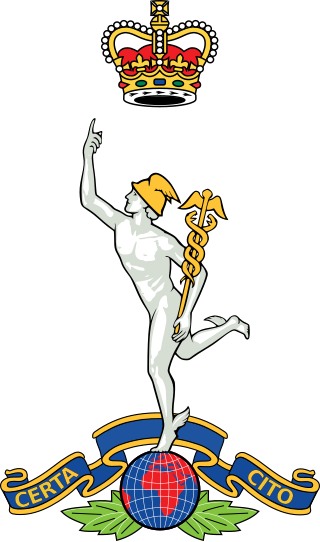
The Defense Information Systems Agency (DISA), known as the Defense Communications Agency (DCA) until 1991, is a United States Department of Defense (DoD) combat support agency composed of military, federal civilians, and contractors. DISA provides information technology (IT) and communications support to the President, Vice President, Secretary of Defense, the military services, the combatant commands, and any individual or system contributing to the defense of the United States.

The Royal Corps of Signals is one of the combat support arms of the British Army. Signals units are among the first into action, providing the battlefield communications and information systems essential to all operations. Royal Signals units provide the full telecommunications infrastructure for the Army wherever they operate in the world. The Corps has its own engineers, logistics experts and systems operators to run radio and area networks in the field. It is responsible for installing, maintaining and operating all types of telecommunications equipment and information systems, providing command support to commanders and their headquarters, and conducting electronic warfare against enemy communications.
MOD Boddington is an installation of Defence Digital, an operating cluster of the Ministry of Defence. It was formerly RAF Boddington, a non-flying Royal Air Force station located in Boddington, Gloucestershire, England, and was the former home of No. 9 Signals Unit RAF.

Corsham is a historic market town and civil parish in west Wiltshire, England. It is at the southwestern edge of the Cotswolds, just off the A4 national route. It is 28 miles (45 km) southwest of Swindon, 20 miles (32 km) east of Bristol, 8 miles (13 km) north-east of Bath, and 4 miles (6 km) southwest of Chippenham.
The Defence Logistics Organisation (DLO) was a key element of the UK Ministry of Defence, responsible for supporting the armed forces throughout the various stages of an operation or exercise; from training, deployment, in-theatre training and conduct of operations, through to recovery and recuperation ready for redeployment.

The United Kingdom's Strategic Command (StratCom), previously known as Joint Forces Command (JFC), manages allocated joint capabilities from the three armed services.

The Royal Air Force's Logistics Command was a command formed to provide logistics support for the RAF.

RAF Rudloe Manor, formerly RAF Box, was a Royal Air Force station north-east of Bath, England, between the settlements of Box and Corsham, in Wiltshire. It was one of several military installations in the area and covered three dispersed sites. Parts of the site are now used by Defence Digital within the MoD Corsham complex; other areas are vacant and some have been sold, including the 17th-century manor house, Rudloe Manor.
The Capability Acquisition and Sustainment Group (CASG) is an organisation within the Australian Department of Defence, responsible for acquisition, supply chain management, and sustainment of military equipment and materiel including aircraft, ships, vehicles, electronic systems, weapons, ordnance, uniforms and rations for the Australian Defence Force. CASG employs more than 7000 military, civilian and contracted staff in more than 70 locations around Australia and internationally.

The Communications and Information Services Corps (CIS) – formerly the Army Corps of Signals – is one of the combat support corps of the Irish Defence Forces, the military of Ireland. It is responsible for the installation, maintenance and operation of communications and information systems for the command, control and administration of the Defence Forces, and the facilitation of accurate, real-time sharing of intelligence between the Army, Naval Service and Air Corps branches at home and overseas.

The 2nd Signal Brigade, was a military formation of the British Army composed of Royal Corps of Signals units. The brigade was first formed following the reorganisation of the old Territorial Army in 1967, and was disbanded in 2012 under the Army 2020 programme. However, later the 2nd Signal Group was formed continuing the lineage of the old brigade, before it was disbanded in 2018.

Defence Equipment and Support (DE&S) is a trading entity and joint-defence organisation within the UK Ministry of Defence. It began operating on 2 April 2007, following the merger of the MoD's Defence Procurement Agency and the Defence Logistics Organisation, under the Chief Executive Officer of Defence Equipment and Support.

Information Systems & Services (ISS) was a cluster within Strategic Command Top Level Budget of the United Kingdom Ministry of Defence. ISS was replaced by Defence Digital in 2019.
The NATO Communications and Information Systems School (NCISS)is a school run by NATO that provides formal technical training on certain Communication and information Systems (CIS) deployed on operations or exercises by the Alliance.

MOD Corsham is a Ministry of Defence establishment located between the towns of Corsham and Box in Wiltshire, England. Since 1998 the site's principal activities concern British Armed Forces and MOD information and communications technology and information warfare.

The Defence High Frequency Communications Service or the DHFCS is a British military beyond line-of-sight communication system operated by the Ministry of Defence (MOD) and used predominately by the UK Armed Forces, as well as other authorised users. The system operates from six transmitting and receiving sites across the United Kingdom and is controlled from a network control centre located at Forest Moor in North Yorkshire and a backup site at Kinloss Barracks in Moray. Overseas sites are located in Ascension Island, Cyprus and Falkland Islands. In 2003 VT Merlin Communications were awarded the contract to operate the system for a period of fifteen years on behalf of the Ministry of Defence. The system is to be replaced by the Defence Strategic Radio Service (DSRS) also operated by Babcock
10 Signal Regiment is a signal regiment of the Royal Corps of Signals within the British Army.
13 Signal Regiment is a signal regiment of the Royal Corps of Signals within the British Army.
This article represents the structure of the Irish Defence Forces as of May 2020:
This is the structure of the British Armed Forces.











